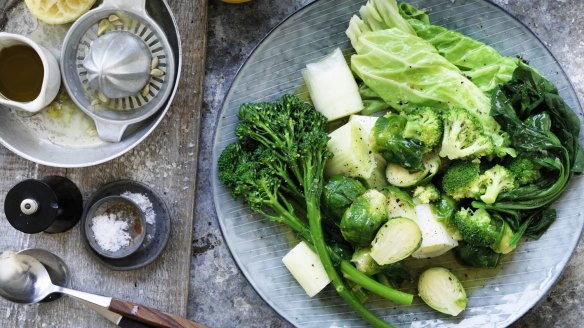Going green: why you should blanch and refresh vegetables

Why blanch and refresh green vegetables? P. Krauth
When you cut an asparagus spear or break the skin of a broad bean, air activates an enzyme called polyphenol oxidase, which then causes unsightly brown pigments to form in the vegetables. This enzyme is deactivated by acid and heat. When you blanch vegetables by quickly scalding them in boiling water, you deactivate the enzyme. Also, tiny pockets of gas inside the vegetable expand and release into the water – you can see these as the little bubbles coming away from the skin of beans and asparagus placed in boiling water. Once this gas has gone, the vegetables look greener. The exterior of the vegetables is also lightly cooked but still raw in the middle. This allows them to hold not only their colour but their texture as well. To stop blanched vegetables from cooking all the way through, they need to be "refreshed" by plunging them into a bowl of water with a good amount of ice. This stops the residual heat from cooking the veg all the way through. If you don't refresh your veg after blanching, they will collapse and begin to release liquid. So, with broad beans, spring peas and asparagus only weeks away, think about a spring salad with blanched vegetables, loads of fresh parsley, lemon rind, good extra-virgin olive oil and some breadcrumbs fried in olive oil with a little garlic and a sprinkle of salt.
Recipes say "juice of one lemon" but some have no juice and others are just dripping. J. Stiller
Depending on how a lemon is grown and its stage of ripeness, it may be laden with juice, about 100 millilitres for a very large meyer lemon, while a stunted Lisbon could yield less than five millilitres. The average lemon gives up about 30 millilitres of juice, the equivalent of two US tablespoons. (Australian tablespoons are 20 millilitres). For baking, it is important to get the correct ratio of liquid to dry ingredients, so use more or less juice as required.
We recently returned from a trip to Mexico and their avocados were tiny. Why? K. Blake
The etymology of avocado is a Spanish-English colonial mangling of the Mexican Nahuatl word ahuacatl, meaning testicle. The original Mexican avocados were no bigger than a hen's egg. The Spanish changed ahuacatl to aguacate, which became avocado in English. Avocados are indigenous to Mexico and other Central America countries and crossed the border into the US in the 1830s. There they were selectively bred to create larger fruit with a greater flesh-to-stone ratio. The Mexicans do grow a lot of the new varieties of avocado, particularly for export but you'll still find the old pre-colonial varieties in the town markets. Central America has incredibly diverse ecology, in some places changing microclimates every few kilometres. An avocado with the same name can be dark-skinned in one valley and light-skinned in another and vary in shape from pointed elliptical to almost baseball-sized and shaped. Some carry names such as criollo and, my favourite, papa rica or "rich daddy".
Send your vexing culinary conundrums to brainfood@richardcornish.com.au or tweet or insta @Foodcornish
The best recipes from Australia's leading chefs straight to your inbox.
Sign up- More:
- How to
- Brain food
